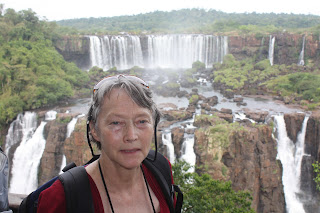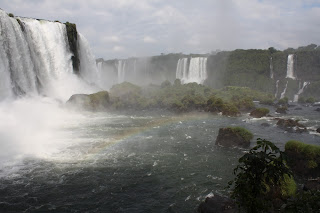When we reached the park, we bought our tickets and boarded double-decker buses that would bring us to the various entry-points for park activities. The Brazilian park is organized differently than the Argentine. In Argentina, there were several different paths available for the general admission price, although there were a couple of private companies running special activities involving boat and tram trips in the park. But in Brazil, the only walkway available to the general admission crowd is at the last of four stops along the way. Each of the three previous stops in the entry-point for a private "adventure," be it rafting, rapelling, or touring by bicycle or tram. A couple of the activities, one of which seemed to be mostly a guided hike along the shore looking at aquatic wildlife, and another of which involved riding a motorized raft up to the very bottom of one of the falls, like the Maid of the Mist in Niagara but closer to the falls and in a smaller vessel, would have interested me. However, the guidebooks to the contrary, there were no agents at the entry area touting their various enterprises, so we did not have occasion to debate between ourselves whether the walk or the boat would have been worthwhile, or whether to take the boat ride.
I found the Brazilian park experience less enthralling than the Argentine, partly because by and large the walkway did not take us as close to the various waterfalls, and even more because almost all the visitors were concentrated on a single walkway, which was, consequently, much more crowded. Still, the views from Brazil were spectacular. Most were views of the Argentine falls.
 | ||
| Salto Tres Mosqueteros behind Nancy, and long wall of Argentine falls that were almost dry on our first day |
By this, our final day in the area, the line of falls off the long cliff in Argentina were largely filled in, so we hd a better view of those falls' glory. We could also see sets of Argentine falls that were simply not visible from the parts of the Argentine park where we had been able to walk. These including the Salto Tres Moqueteros, the falls to which the Brazilian rafts take their passengers.
 |
| Salto Tres Mosqueteros |
And although I don't think we were any closer to the Gargantua on the Brazilian side, we were face to face with its rushing waters, not near the top as over in Argentina, hence the display of sheer water force and power was greater.
 |
| Gargantua del Diablo |
We also got close to the Santa Salto Maria on the Brazilian side.
 |
| Salto Santa Maria, with Argentine-side falls behind -- and a rainbow |
After touring the falls, we had a buffet lunch at the Porto Canoas facility in the National Park. It was reasonably priced and although the meat selections were a bit limited, there was a wide variety of starches, salads and desserts. We could see the broad river lazily flowing toward the falls from the deck outside the restaurant (of course, we had chosen the outdoor seating). After gazing at the river and the mist rising from the falls for some time, we took the bus back to the entry area, where we walked through the exhibition which was even more perfunctory than the Argentine. Even worse, the English (and Spanish) language versions of the explanatory text was generally in a green or blue font which, against the dark colored illustrations, was often unreadable, especially by my older eyes.
But we finally saw a toucan -- inside the entrance building, flying around in the rafters.
 |
| Toucan in the rafters |
For our final dinner in Puerto Iguazu, we went to La Rueda Restaurant down the street from our hotel. It was the best meal we had in Puerto Iguazu. We had two salads, the capressi and a salad of arugula with roasted cashews, grilled onions, dried tomatoes and onions; my main dish was a grilled suburi perfumed with passion fruit sauce (m'burucuya), plus caramelized onions and an onion chutney (the fried manioc pieces were not an inspired addition to the dish). Even the spread for the nice collection of breads was unusually good: a combination of blue cheese, cream, and ample garlic.
As we walked back to our hotel, we paused across the street from Color restaurant. When we had passed by on the way to La Rueda, there had been an electric organ player performing; but now he was accompanied by a singer with a very nice voice. We listened to a couple of songs, then headed into the hotel. We had to head to the airport in the morning, with a long travel day by plane and bus facing us, and we wanted to get a good night's sleep. Still, I could not resist watching part of the Copa Libertadores game between Boca Juniors and Fluminense before falling asleep.
No comments:
Post a Comment